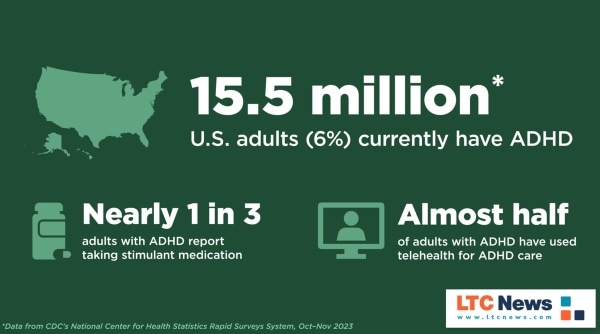ADHD, Aging, and Telehealth: Adapting Together

Table of Contents
- What ADHD Looks Like After 45
- Why ADHD Management Matters More as You Age
- Why it Can Get Harder Over Time
- How Telehealth is Changing ADHD Care
- Are Online ADHD Evaluations Reliable?
- Medication Management and Safety in Older Adults
- Making Telehealth Work for You
- Choosing a Credible Telehealth Provider
- Emotional Support Animals Can Help Calm the Chaos
- Getting Legitimate ESA Documentation
- Planning Ahead: ADHD, Aging, and Long-Term Care
- Looking Ahead
- Frequently Asked Questions
If ADHD has been part of your life, whether it’s your own or someone you love, you know it’s not just about being “distracted” or “forgetful.” It’s the missed appointments that throw off the week, the bills left unopened on the counter, the constant tug-of-war with focus and follow-through.
For some, it’s been a lifetime of learning how to work around it. For others, the diagnosis came later, when the daily friction finally had a name. But something changes as the years go by. The routines that once helped keep everything steady may fade with retirement. Energy isn’t the same. Health concerns stack up, medications, blood pressure checks, memory slips, and ADHD don’t just disappear into the background. In fact, it can get louder.
And if you’re the one standing beside that person, a partner, adult child, or close friend, you see it too. You may already be stepping in quietly: reminding, organizing, nudging. You love them, but it’s hard watching someone you care about struggle with the same things that have followed them for years, now complicated by aging and new health challenges.
This isn’t a story of failure. It’s a story about reality and how understanding ADHD later in life can help protect dignity, independence, and well-being for everyone involved.
With the right support, planning, and care, aging with ADHD doesn’t have to mean losing control. It can mean adapting together. There are many ways to get treatment, but long wait times for appointments, geographic limitations, and the time commitment of in-person visits can disrupt the very consistency that effective ADHD treatment depends on.
Telehealth platforms are changing this reality by delivering comprehensive ADHD care through video consultations, digital prescription management, and streamlined follow-up appointments.
What ADHD Looks Like After 45
Attention-Deficit/Hyperactivity Disorder (ADHD) is a neurodevelopmental condition characterized by ongoing patterns of inattention, hyperactivity, and impulsivity that interfere with daily life.
In the U.S., about 8–10 percent of children and approximately 4–5 percent of adults are estimated to have ADHD, according to the Centers for Disease Control and Prevention (CDC).

If you're unsure whether your symptoms or those of a loved one might warrant a full medical evaluation, taking a preliminary free ADHD test powered by ADHD Advisor on ChatGPT can help you decide if pursuing a formal diagnosis makes sense.
Licensed providers then conduct thorough clinical interviews, review your medical and educational history, use standardized rating scales, and often gather input from family members or teachers.
Many adults aren’t diagnosed until later in life, often after years of coping with unrecognized symptoms.
ADHD doesn’t fade with age — but how it shows up can shift:
- Routines may unravel. Retirement can remove the structure that helped keep symptoms manageable.
- Memory slips can increase. Forgetting appointments or misplacing medications may become more frequent.
- New health issues layer on. Managing blood pressure, diabetes, heart conditions, or sleep apnea can strain already taxed executive function.
- Mood and emotional regulation may shift. Older adults with ADHD often report increased anxiety, frustration, or feelings of being overwhelmed.
Emerging research has also linked ADHD with a higher risk of cognitive decline and dementia. However, the relationship between dementia and ADHD is still being studied.
Recent epidemiological studies show that adults suffering from ADHD have an increased risk of dementia at an advanced age, but the mechanism through which ADHD constitutes a risk is not known. — Professor Paul G. Unschuld, head of the Division of Geriatric Psychiatry of the University Hospitals of Geneva, Associate Professor in the Department of Psychiatry at the UNIGE Faculty of Medicine.
Why ADHD Management Matters More as You Age
As you get older, managing daily life often becomes more complex, not less. More medications. More doctor visits. More financial decisions. More health concerns.
For someone with ADHD, these growing responsibilities can collide with long-standing challenges in focus, memory, and organization — making even simple routines harder to maintain.
ADHD affects executive function, the brain’s “management system” that controls planning, attention, working memory, emotional regulation, and follow-through.
These skills help you:
- Remember appointments and medication times
- Manage bills and household responsibilities
- Organize information and tasks
- Focus long enough to complete the steps in a process
When executive function is already working harder to keep up, as it often is in ADHD, age-related changes in the brain can magnify the strain.
Those who experience overlapping symptoms like headaches triggered by ADHD-related stress may find that certain over-the-counter solutions may offer instant migraine relief while you wait for formal adjustments to medication. Staying on top of health issues is critical.
Why it Can Get Harder Over Time
- Brain aging affects working memory and processing speed. Even in people without ADHD, these skills naturally decline with age. For someone with ADHD, that decline can be more noticeable. Tasks like remembering a dose schedule or following multi-step instructions may feel more frustrating or overwhelming.
- Attention and focus can become less flexible. Many people with ADHD learn strategies to “push through” distractions. But as cognitive reserves shrink with age, those strategies may not work as well, making it harder to manage competing demands.
- Transitions, like retirement, remove external structure. Work, school, or parenting often provides built-in routines. When those routines disappear, ADHD symptoms can feel amplified because there’s less daily scaffolding to keep things on track.
- New health issues add layers of complexity. Managing blood pressure, heart disease, diabetes, or chronic pain requires planning, memory, and follow-through — exactly the skills ADHD can compromise.
- Sleep and medication interactions can play a role. Poor sleep, which is common with aging, can worsen inattention and forgetfulness. Certain medications for other conditions can also interact with ADHD symptoms or treatment.
ADHD itself doesn’t necessarily worsen with age, but its impact often grows because cognitive reserves decline and daily demands shift. Some adults may also develop mild cognitive impairment or dementia, which can blur the line between ADHD symptoms and new neurological changes.
ADHD doesn’t disappear with age — but the safety nets around it can. When those supports fall away, symptoms can seem to get worse, even when the underlying condition hasn’t changed. — Dr. David Goodman, assistant professor of psychiatry at Johns Hopkins School of Medicine.
This growing gap between daily demands and the brain’s ability to keep up is why early, consistent ADHD management in midlife and beyond is so critical. It helps reduce stress, protect safety, and preserve independence — not only for the individual, but also for their family.
How Telehealth is Changing ADHD Care
Traditional ADHD treatment often involves frequent appointments with psychiatrists or primary care providers. But for older adults, especially those with mobility or transportation barriers, in-person care can be inconsistent. Telehealth has shifted that landscape.
Telehealth allows people to:
- Complete ADHD evaluations remotely through structured video assessments.
- Access medication management from home with licensed providers.
- Schedule flexible follow-up appointments that fit around their lives, not the other way around.
- Receive reminders and secure messaging to improve treatment adherence.
According to a 2023 study from Mass General Brigham published in JAMA Psychiatry, patients receiving ADHD medication prescriptions via telehealth were no more likely to develop substance use disorders compared to those treated in person.
The U.S. Drug Enforcement Administration has also extended pandemic-era telehealth flexibilities for prescribing controlled medications through December 31, 2025, allowing legitimate providers to prescribe stimulant medications after appropriate evaluation.
Are Online ADHD Evaluations Reliable?
Yes — when done right. Virtual ADHD evaluations use the same diagnostic criteria as in-person care:
- Comprehensive clinical interviews
- Standardized rating scales
- Medical and educational history review
- Collateral input from family or caregivers
Research has shown that virtual ADHD assessments can be just as accurate as in-person evaluations when conducted by qualified professionals.
However, complex cases, particularly those involving multiple chronic illnesses, significant anxiety, or communication challenges, may benefit from a hybrid model, combining telehealth with occasional in-person visits.
Medication Management and Safety in Older Adults
ADHD medications, including stimulant and non-stimulant options, can be effective for older adults, but careful monitoring is key.
- Cardiovascular health: Studies published in JAMA Psychiatry and The Lancet show mixed results; some indicate no overall increased cardiovascular risk, while others note higher risk with long-term use, particularly hypertension. Regular blood pressure and pulse checks are recommended.
- Regulatory safeguards: Telehealth platforms must comply with federal and state laws governing controlled substances, including Prescription Drug Monitoring Program (PDMP) checks.
- Tailored dosing: Lower doses are often used for older adults, with regular monitoring for side effects such as increased heart rate or anxiety.
We often find that older adults respond well to lower, carefully titrated doses. The key is regular follow-up and clear communication. — Dr. David Goodman, assistant professor of psychiatry at Johns Hopkins School of Medicine.
Making Telehealth Work for You
Small, consistent systems can make ADHD care more manageable:
- Use one calendar for everything — appointments, medication refills, and reminders.
- Prepare before each visit. Write down wins, struggles, and side effects.
- Automate refills and use delivery pharmacies to avoid gaps in medication.
- Give a trusted loved one portal access if you need extra support.
- Choose a private space for telehealth visits to ensure confidentiality.
Choosing a Credible Telehealth Provider
Look for these signs of a reputable service:
- Licensed psychiatrists or nurse practitioners in your state
- Transparent privacy policies and HIPAA compliance
- Clear prescription and follow-up protocols
- Insurance acceptance or clear self-pay pricing
- Integration with your primary care or specialty providers when needed
Emotional Support Animals Can Help Calm the Chaos
For some people living with severe ADHD, emotional support animals (ESAs) offer more than companionship; they can help bring structure, calm, and connection to daily life.

While ESAs are not the same as service animals, they can play a powerful role in emotional regulation.
- Grounding and calming effects: Many people with ADHD experience racing thoughts and restlessness. Having a pet to care for can lower stress hormones, encourage mindfulness, and provide comfort during moments of overwhelm.
- Daily structure: Feeding, walking, or grooming a pet creates built-in routines, which can help anchor time management and reduce forgetfulness.
- Improved emotional well-being: Studies show that interacting with animals can boost mood, reduce anxiety, and help people feel less isolated — benefits that matter even more as people age.
For older adults or caregivers, ESAs can provide emotional stability and gentle accountability without medical interventions.
If you or a loved one is considering an ESA, you should talk with your doctor to determine whether it’s the right fit for your lifestyle, home, and health needs.
Getting Legitimate ESA Documentation
If you or your loved one is considering an emotional support animal, it’s essential to work with licensed mental health professionals. Some professionals and websites connect you with licensed mental health professionals for legitimate emotional support animal assessments, and quality ADHD telehealth services prioritize working with properly credentialed providers who conduct thorough clinical evaluations.
A legitimate ESA letter must come from a state-licensed clinician (such as a psychiatrist, psychologist, or therapist) who can evaluate your condition and determine if an ESA is appropriate.
Planning Ahead: ADHD, Aging, and Long-Term Care
As ADHD interacts with aging, planning early can protect independence and reduce crisis moments later. Having ADHD does not prevent you from obtaining Long-Term Care Insurance, as long as it is stable and controlled and does not impact your ability to work and perform normal living activities.
Learn More: Underwriting and Long-Term Care Insurance
If executive function or cognitive symptoms worsen over time, having supports in place matters:
- Establish legal and financial protections. Durable powers of attorney for health care and finances can prevent chaos later.
- Use the LTC News Cost of Care Calculator to understand the cost of home care, assisted living, and other long-term care options in your area.
- Explore the LTC News Caregiver Directory to find vetted home care providers and long-term care facilities.
- Talk openly with loved ones about your preferences and needs.
- Consider purchasing Long-Term Care Insurance while still insurable, which can help pay for home health aides, assisted living, or adult day services.
Experts say that having an LTC Insurance plan in place isn’t about giving up control; it’s about keeping it.
Red Flags That Signal It’s Time for Extra Help
ADHD symptoms can blend with cognitive or health-related changes over time. Watch for:
- Missed medications or double-dosing
- Increased anxiety or agitation
- Unpaid bills piling up
- More frequent falls or household accidents
- Growing caregiver burnout
These are signs to bring in extra support — whether through a care manager, telehealth follow-up, or structured long-term care planning.
Looking Ahead
Telehealth isn’t a magic cure, but it’s a powerful tool. It removes barriers, creates consistency, and helps older adults with ADHD and their families manage care without constant disruptions. More importantly, it allows you to focus on living, not just coping.
ADHD doesn’t have to define aging. With the right care, technology, and planning, you can stay connected, independent, and supported.
Frequently Asked Questions
Is telehealth for ADHD covered by insurance?
Yes. Many private insurers and Medicare cover behavioral telehealth visits, including audio-only options in many states. Coverage varies by plan.
Can stimulant medications be prescribed through telehealth?
Yes. Federal telehealth prescribing flexibilities are extended through December 31, 2025, but providers must follow state and federal laws.
Can ADHD increase dementia risk?
Some research suggests a correlation between ADHD and cognitive decline, but it’s still being studied. Regular health monitoring is recommended.
What if my loved one resists treatment?
Start with small, supportive steps — not ultimatums. Offer to help set up appointments, create reminders, or sit in on telehealth visits if invited.


